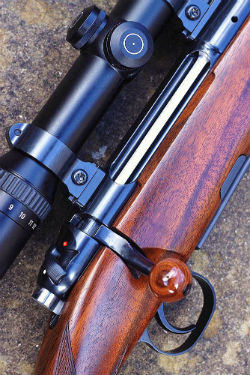James Mott explains the drill in the event of a Misfire or Hangfire.
 As a deer stalker, in the rare event of experiencing a misfire, you should know what to do. This article explains the procedure to deal with it and the potential problems associated with it.
As a deer stalker, in the rare event of experiencing a misfire, you should know what to do. This article explains the procedure to deal with it and the potential problems associated with it.
So you've just aimed at the target, squeezed the trigger and then nothing happens.
What you have experienced is a misfire. A misfire is when the firing pin strikes the bullets primer component and nothing happens. In the eventuality that you hear a ‘click’ instead of the usual BANG, you must keep the barrel of your gun pointing down range or in a safe direction and wait 30 seconds.
The reason for doing so is in case of a ‘hangfire’ (delayed discharge). A ‘hangfire’ is essentially an unexpected delay between the triggering of a firearm and the ignition of the propellant. The time delay can vary; it may only be a fraction of a second to many seconds later. It is important to follow the misfire procedure detailed below, to avoid a potentially dangerous situation.
Misfire Procedure
Following a misfire, keep the muzzle pointing in a safe direction and wait 30 seconds.
Observe whether or not the bolt has been closed properly (if not, this may be the problem)*
Open the chamber, keeping your face and body away from the chamber port. Lift the bolt swiftly upwards by the fingertips, minimising any exposed body parts to any possible blast from the chamber port.
Dispose of the ejected round safely.
*If the rifle’s bolt was closed properly, it’s better to be safe than sorry – take your gun to a qualified gunsmith to investigate the problem for you.
Common Causes
 1) Not shutting the bolt properly (user error). This can be a problem particularly with straight pull rifles where there is the tendency to pull and throw the bolt back without making sure it is closed properly. This also commonly occurs with new rifles that are a little stiff before they are ‘broken in’.
1) Not shutting the bolt properly (user error). This can be a problem particularly with straight pull rifles where there is the tendency to pull and throw the bolt back without making sure it is closed properly. This also commonly occurs with new rifles that are a little stiff before they are ‘broken in’.
2) Weak firing pin strike – firing pins are usually well hardened to take the repeated firing and contact with the primer to initiate the ignition process, but over time they can become damaged by loose brass filings, fouling or harsh use, so that the end of the pin can be reduced in length, thus not reaching as far forward as usual. Additionally, the spring that tensions the firing pin can become weak through use, the result being that the primer may not be struck as forcefully as is needed.
3) Wrong grease (particularly in cold winter conditions) which can inhibit the action of the firing pin. In winter, the grease used to lubricate the bolt firing mechanism can become more viscous and thus slow down the speed at which the firing pin strikes the primer, the result being a misfire.
4) Dud cartridge (factory ammunition) – whilst factory ammo these days is manufactured to high standards, it is not unknown that the cartridge is fitted with a dud primer or the powder fails to ignite (usually due to poor storage).
5) Reloading problems – including, use of badly stored powders, wrongly positioned primers and case sizing issues.
6) Badly maintained firearms – regular cleaning and maintenance of firearms is essential. In particular make sure the bolt and chamber is clean of fouling.
Modern guns and ammunition have improved to the point where hangfires are uncommon; however they are still possible in certain conditions. Misfires are far more common and should always be treated as if they could become a hangfire.
 James Mott is a director at County Deer Stalking and is directly responsible for running CDS Training & Courses.
James Mott is a director at County Deer Stalking and is directly responsible for running CDS Training & Courses.
The two stage proficient-stalker course is designed to provide first class training and mentoring to stalkers wherever they are on the journey. Beginner or seasoned hunter, if you would like guidance with firearms training, this can be achieved via one of our courses. Call James on 01403 790244 or email
Follow this link to read more about our proficient-stalker course.
Alternatively to read more from James follow this link: improve-your-marksmanship



















